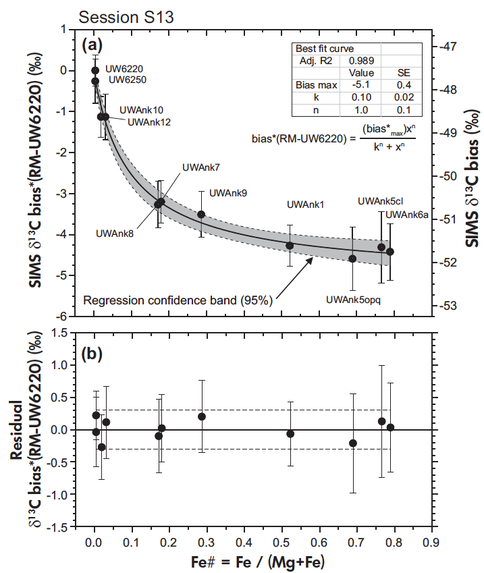2015 Annual Science Report
 University of Wisconsin
Reporting | JAN 2015 – DEC 2015
University of Wisconsin
Reporting | JAN 2015 – DEC 2015
Project 4B: New Standards for Analysis of O and C Isotope Ratios in Ca-Mg-Fe Carbonates
Project Summary
Stable isotope ratios are a powerful tool for determining the temperature and fluid conditions during formation of carbonates that host evidence for early life on Earth. However, sedimentary carbonates are often zoned at μm-scale and conventional analysis yields average values. We developed a suite of standards for the dolomite-ankerite series that allow us to make the first accurate SIMS (Secondary ion mass spectrometry) analyses oxygen and carbon isotope ratios at 1-10 μm-scale for these important carbonate minerals.
Project Progress
Given the great importance that stable isotope geochemistry plays in topics of interest to NAI, it is sobering to learn by SIMS analysis that μm-scale variability within mm-scale sample-volumes can be more than 100 times larger than the uncertainty of a conventional analysis (e.g., Cammack et al. 2015, Sliwinski et al. 2016). Samples with internal variation of over 10‰ have commonly been reported with a single value (±0.1‰) without knowledge of systematic zoning or random variability. The ability to resolve these μm-scale patterns by SIMS will lead to a more fundamental understanding the environments for early life.
Because of the high precision capabilities of the large radius multicollector ion microprobe, previously used standards must be reevaluated. We report 14 new standards for analysis of δ[^18]O and δ13C by SIMS in the dolomite-ankerite series (Fe# = 0 to 79). We sought natural materials that are homogeneous and match samples as closely as possible (synthetics are frequently fine grained or zoned). The identification and calibration of these 14 standards required obtaining 67 potential standards by purchase or loan and initial screening by SEM over the course of two years. Thirty materials were then crushed, sieved and purified, and 20 grains of each were cast in epoxy mounts for evaluation of homogeneity by EPMA (major elements) and SIMS (O & C isotope ratios, 40-50 analyses/each). The 14 homogeneous samples were then calibrated against NIST standards using special sealed vessels with phosphoric acid at 75oC and gas-source mass spectrometry. For the dolomite-ankerite series, bias varies by 11‰ and assuming linearity would cause errors up to 5‰ in δ18O (Fig. 1, Sliwinski et al. 2015a). Comparable, but inverted, trends are seen for δ13C (Fig. 2). Fortunately, the variation of bias vs. Fe/Mg is systematic for O and C, and can be accurately corrected through calibration with appropriate standards. Data are precisely fit by a “Hill function” and accurate corrections, within ±0.5‰, can be made for all compositions (Sliwinski et al. 2015a, b). The large magnitude of instrumental bias due to matrix effects, the extreme curvature of bias vs. Fe#, and the systematic variation were all a surprise.
Publications
-
Kita, N. T., Sobol, P. E., Kern, J. R., Lord, N. E., & Valley, J. W. (2015). UV-light microscope: improvements in optical imaging for a secondary ion mass spectrometer. J. Anal. At. Spectrom., 30(5), 1207–1213. doi:10.1039/c4ja00349g
-
Schopf, J. W., Kudryavtsev, A. B., Walter, M. R., Van Kranendonk, M. J., Williford, K. H., Kozdon, R., … Flannery, D. T. (2015). Sulfur-cycling fossil bacteria from the 1.8-Ga Duck Creek Formation provide promising evidence of evolution’s null hypothesis. Proc Natl Acad Sci USA, 112(7), 2087–2092. doi:10.1073/pnas.1419241112
-
Sliwinski, M. G., Kozdon, R., Kitajima, K., Denny, A., & Valley, J. W. (2016). Microanalysis of carbonate cement δ18O in a CO2-storage system seal: Insights into the diagenetic history of the Eau Claire Formation (Upper Cambrian), Illinois Basin. AAPG Bulletin, 100(06), 1003–1031. doi:10.1306/02031615065
-
Śliwiński, M. G., Kitajima, K., Kozdon, R., Spicuzza, M. J., Fournelle, J. H., Denny, A., & Valley, J. W. (2015). Secondary Ion Mass Spectrometry Bias on Isotope Ratios in Dolomite-Ankerite, Part I: δ18O Matrix Effects. Geostand Geoanal Res, 40(2), 157–172. doi:10.1111/j.1751-908×.2015.00364.x
-
Śliwiński, M. G., Kitajima, K., Kozdon, R., Spicuzza, M. J., Fournelle, J. H., Denny, A., & Valley, J. W. (2015). Secondary Ion Mass Spectrometry Bias on Isotope Ratios in Dolomite-Ankerite, Part II: δ13C Matrix Effects. Geostand Geoanal Res, 40(2), 173–184. doi:10.1111/j.1751-908×.2015.00380.x
-
PROJECT INVESTIGATORS:
-
PROJECT MEMBERS:
Jake Cammack
Co-Investigator
Noriko Kita
Co-Investigator
Kouki Kitajima
Co-Investigator
Reinhard Kozdon
Co-Investigator
Mike Spicuzza
Co-Investigator
-
RELATED OBJECTIVES:
Objective 1.1
Formation and evolution of habitable planets.
Objective 4.1
Earth's early biosphere.
Objective 4.3
Effects of extraterrestrial events upon the biosphere
Objective 7.1
Biosignatures to be sought in Solar System materials


